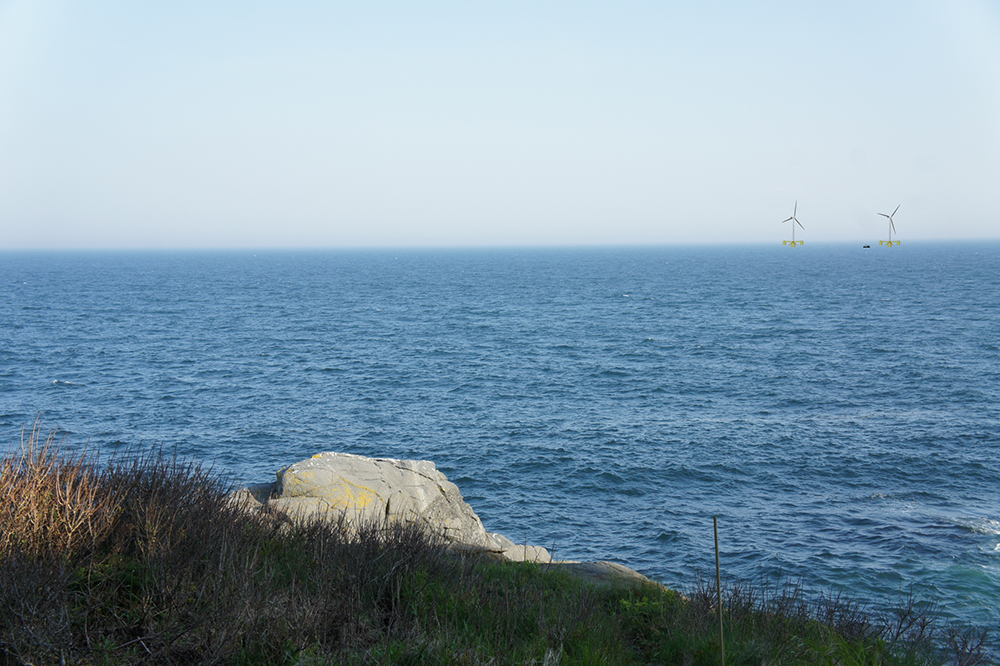A small group of Monhegan residents and their supporters have organized a bid to block plans to test two full-scale floating wind turbines 2½ miles off the island.
Its formation may signal a new split among those who value the island primarily for its remote sensibilities and artistic inspiration, and those who also see room for energy research and economic benefits.
The group, called Protect Monhegan, said in a news release Tuesday that the project would do “irreparable harm” to their community, which is 10 miles off the Maine coast. It’s asking the University of Maine-led consortium that’s developing the project to move the site farther away.
“Simply put, Monhegan is no place to experiment with wind turbines or to establish a commercial wind farm, any more than it would be to place these massive turbines this close to Acadia National Park or Mt. Katahdin,” wrote Travis Dow, a year-round resident and outspoken critic of the project. “Surely there must be other locations in the vast Gulf of Maine that would serve your purposes without forever marring Monhegan’s unrivaled 360-degree view of the ocean and incredible night skies.”
Concerns about impacts date back to 2009, when the site was chosen after a state assessment for offshore wind power potential. But what’s notable now is that, according to Dow, Protect Monhegan has quickly raised $40,000 to fight the project, some of it from visitors and summer residents. It has hired a veteran Portland public affairs consultant, Ted O’Meara, and Jon Doyle, a former assistant attorney general, with a goal of amending legislation that helped create the test site.
It’s not clear, however, that Protect Monhegan represents many of the 60 or so year-round residents. Winnie Murdock, who chairs the plantation-sanctioned Monhegan Energy Task Force, said a survey has shown that most residents accept the turbines, but want to negotiate the best deal they can for the community.
“It makes the process more contentious than it needs to be,” she said. “I don’t think they have broad enough support on the island to merit that much attention.”
Those negotiations are ongoing with the university through Jake Ward, the school’s vice president for innovations and economic development. Ward said the site was picked based on water depth, wind resources and fewer conflicts with other activities, such as lobster fishing. The selection also survived a 2010 lawsuit.
“There is not a path for moving the project, under the current circumstances,” Ward said.
The project is being developed by New England Aqua Ventus, which includes the university, Emera Inc. and Cianbro Corp. It already has tested a one-eighth scale version of the turbine off Castine. That’s what was originally proposed for the waters off Monhegan, but development delays led researchers to shift the small-scale test site to Castine.
Success with a floating concrete platform design helped Aqua Ventus win a $40 million federal grant, critical to building two full-size platforms for testing off Monhegan in 2018. Those platforms would hold 6-megawatt turbines, each with the capacity to power 3,000 average homes.
The turbines would float 395 feet above the water. Aqua Ventus has produced photo-simulations that indicate what they would look like from a handful of locations on the island. Online, they appear to be small pinwheels with yellow bases on the horizon.
But Dow doesn’t trust the depictions.
“I don’t think it’s a fair representation,” he said. “They are very misleading. They show them in a corner. It’s a hazy day. And there’s nothing to compare the scale.”
The two turbines would send power through an undersea cable to the mainland.
That cable also could be used to help provide electricity to Monhegan, which currently relies on diesel generation. As a result, residents pay power rates four times higher than most Mainers.
Last summer, residents voted to form a committee to negotiate with Aqua Ventus for community benefits. One option, set forth in the project’s rate approval at the Maine Public Utilities Commission, was for the island to get power and fiber-optic communications from the cable at no cost. A more recent idea is to receive a payment in lieu of the cable, possibly $200,000 a year for the 20-year life of the project. The money could go to developing cleaner, cheaper power that could be generated on the island, for instance.
Murdock said residents seem split over which option would be better, but most have accepted the turbines and want to move forward.
“I don’t think anyone really cares about the lower power bill,” she said. “We’ve learned to live with that. The issue is, what’s the best thing for Monhegan, even if we have different opinions?”
Send questions/comments to the editors.



